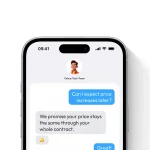CityFibre Officially Launch 2.5Gbps FTTP Home Broadband Tier

As expect, CityFibre has today announced that they’ve officially made a new 2.5Gbps (symmetric) speed consumer UK broadband tier available at wholesale for their retail ISPs to sell on to customers, which harnesses the operator’s new 10Gbps capable Fibre-to-the-Premises (FTTP / XGS-PON) network.
The launch doesn’t come as much of a surprise because we’ve already seen Vodafone trial a 2Gbps package on the new network at the start of this year (here), which in June 2023 was followed by Yayzi’s earlier than expected launch of a new 2.5Gbps package (here) – this all but confirmed CityFibre’s plan. Since then, we’ve noted that other providers, such as AAISP (Andrews & Arnold), have also setup packages for a similar tier (here).
The new 2.5Gbps product is being made available to its ISP customers on a “rolling basis“, starting in their most mature XGS-PON deployment areas, before reaching all homes served by its XGS-PON based full fibre platform in the coming months. The new platform is capable of supporting symmetrical speeds of up to 10Gbps and is designed to be easily upgraded to 50G PON.
Advertisement
However, those still stuck on the operator’s older GPON network, will not be left out. This will be achieved via a 2Gbps/1Gbps asymmetric GPON product that CityFibre plans to launch in the “coming months” (these services will ultimately be migrated to the XGS-PON platform when available).
CityFibre CEO, Greg Mesch, said:
“With the launch of the UK’s fastest and most cost-effective connectivity products, we are demonstrating the benefits of infrastructure competition and raising the bar for all wholesale networks. Ubiquitous, high-quality, low-carbon connectivity is the keystone of all advanced and community-wide applications of the future. By working with our ISP partners to bring symmetrical multi-gigabit broadband consumer services to market today, with businesses to follow, the UK will finally have a network and services that will enable our future, rather than holding it back.”
By the end of 2023, CityFibre expects to have deployed its XGS-PON equipment into over 90% of its fibre exchanges, with the new 2.5Gbps product becoming available to around 20% of its Ready for Service footprint. The operator also highlighted how its symmetrical 2.5Gbps service is 2.5 times faster than Openreach’s (BT) asymmetric 1Gbps product, at “half the rental cost per megabit” and it provides more than 20 times the upload speeds of Openreach’s piloted 1.8Gbps GPON service. The move also steals a march on Virgin Media’s expected plans to launch a 2Gbps tier.
As usual, the catch here is that harnessing a speed of 2.5Gbps online is still rather tricky, particularly since it’s already difficult enough to max out a 1Gbps line via most online services (Why Buying Gigabit Broadband Doesn’t Always Deliver 1Gbps), although some platforms (e.g. Steam, Microsoft) are catching up. In that sense, this is perhaps more about marketing than meeting genuine need. But that’s all fair play.
CityFibre aims to cover up to 8 million UK premises (funded by c.£2.4bn in equity and c.£4.9bn debt) – across over 285 cities, towns and villages (c.30% of the UK) – by the end of 2025 (here). But it’s looking less and less likely that they’ll reach this goal before 2026.
Advertisement
Mark is a professional technology writer, IT consultant and computer engineer from Dorset (England), he also founded ISPreview in 1999 and enjoys analysing the latest telecoms and broadband developments. Find me on X (Twitter), Mastodon, Facebook, BlueSky, Threads.net and Linkedin.
« EE UK Partners NVIDIA to Launch New Cloud Gaming Bundles
Three UK Tops Ookla’s H1 Study of 5G Mobile Broadband Speeds »






















































“Pointless.. I don’t need 2.5G therefore nobody does”
In before the gloomers start posting this usual rubbish.
Well said!
We are in a different era now. 5 – 10 years ago, most people benefited when top speeds were raised. As most internet tasks, even loading the BBC home page were not instant. Nowadays on most connections load pages and images are fairly quick to load to the point of being instant. 90% of what people do on the internet is not held back by speed any more. Those people who all followed these articles about speed increases, such as when ADSL2+ or VDSL was rolled out no longer care about fibre upgrades. Yet they come on these articles out of nostalgia or habit and comment to say that this isn’t needed.
lol. People who don’t want these faster speeds can, at least, enjoy downward pressure on the pricing of their desired tier.
Let me offer a different thought, that the focus on highest speeds (by any ISP) is not a bad thing, but is fighting yesterday’s war. These days, even if you’re on FTTC, most people are more concerned by end to end reliability and connection quality than by raw speed, but they probably can’t articulate that well beyond “my internet is ****” and mostly wouldn’t know the relevance of packet loss, latency and network availability figures if they had them, nor can they disaggregate and manage the different elements of broadband, wifi, service, and platform.
Give it 6 months before they shut up about not needing 2.5gbps. As soon as games start to come out at over 150GB in size on a regular basis it’ll be ‘why didnt Microsoft include a 2.5bge port on my xbox series X?’.
K, games are already around that size, and even bigger by the time you add some modifications or DLC’s to them. Several games are already upwards of 100GB even today.
There are always customers who will be able to make use of higher bandwidth, notably gamers. It seems that the real issue here is whether their internal networks will be able to make use of it. I wired my house in Cat 5e 15 years ago with 100mb switches and have upgraded to gigabit switches over the years, I recently went up to 900 FTTP but I am now at the limit of what my current cabling can handle. Do I wish to replace my network cabling again and switches? Probably not. As with everything the law of diminishing returns will apply and the faster it goes the smaller the perceived benefit will become and it will just become a marketing exercise.
@”K”
I have a Series X and it can’t even max out my Leased Line. The max I have seen is 824mbps and that’s been downloading Battlefield which is 134GB.. But good point however well made
Charles:
The reason why that is, is because the Xbox only has a gigabit lan port. If you do a test on your X it will tell you the max it can download at, which for us is around 780-800meg. If it had a 2.5gbe port it would probably max out at around 2200mbits or thereabouts.
@Big Dave… Roughly the same boat here except it’s only my devices hard wired (PS5, XSX, Desktop). Everything else in the house uses Wifi (kids Xbox’s, TV’s, laptops, phones).
I’m also on Fibre 900 (BT) and tbh will probably keep upgrading as faster packages become available.
(I do a lot of syncing to/from Perforce, Github, etc)
FYI… Whilst Cat5e isn’t certified for 10GbE, as long as you have decent connections, the cable’s decent quality and aren’t running it besides power you can generally obtain the same performance as Cat6 (so 10GbE upto 50m).
Big Dave: “There are always customers who will be able to make use of higher bandwidth, notably gamers.”
Well, if they spend more time downloading than playing that’s certainly the case, but it’s amazing the number of gamers who think that the quality of their gaming connection is improved by having a multi-hundred megabit connection, and as a result end up paying more for a technically inferior but high bandwidth cable connection.
And the company behind UK cable has always had support staff happily assuring customers who complained about poor ping that buying a speed upgrade would fix it.
How do you know it’s pointless? Comments like yours are the reason why new infrastructure upgrades are delayed from being installed when there is a critical requirement for them, especially when you consider the progress we’ve made over the last 10 years—from ADSL to VDSL and now all the way to GPON. Additionally, people’s bandwidth requirements have doubled, particularly with the shift from ADSL2’s maximum of 24 megabits to the current trend of people pulling anywhere from 100 to 200 megabits while engaging in activities such as watching television and gaming.
CAT5e supports 2.5Gbps, so you don’t need to replace your cabling.
Yes’ you’d need new switches (not to mention devices to plug into it) to gain from that speed. But do you really need it? Almost certainly not. In most cases, the limiting factor is how fast the end device can accept and store data, not the speed of the link itself.
NE555:
I just bought a USB drive which can transfer 200MBytes+ per second which works out at 2Gbits it can utilise. A typical NVME drive can transfer 2Gbytes in a few seconds so they are able to use connections which are 20Gbps transfer rate. So even if you had a 10Gbit connection you could still not be using the full transfer rate that your computer could use, if you bought a computer in the last couple of years.
As a final thought they are already talking about 100 gigabit and beyond, that would suggest to me that we now need to think beyond copper lans and start talking in terms of pon based lans with Routers with optical lan ports, optical switches and optical nics on devices.
@Darren Reid
Yes Darren, we’re in a very different era now. A typical household will have dozens of devices streaming all kinds of media, doing background updates, downloading huge games, etc, simultaneously. Gigabit and multi-gigabit is useful to large modern households.
We are now pass the Margaret Thatcher 1992 decision to block bt from replacing the copper network and going 100% fiber (this was off there own back no government money) maybe another 7 years and there be no copper remaining
VDSL was a whole waste of money and time when it was going to be replaced for fiber (but openreach/bt just wanted government money to pay for the free upgrade to VDSL because they stopped them last time from going full fiber
It will be interesting to see how retail providers handle the service fragmentation across the Cityfibre network as far as the XGS-PON/GPON regions are concerned. I wouldn’t expect to see much of the 2Gb/1Gb product if it’s only going to be something that exists on 10% of the network and marketing it alongside the full range of symmetric products could be a challenge.
Anything that pushes 2.5Gb ports down in price and into more devices is welcome.
> CityFibre expects to have deployed its XGS-PON equipment into over 90% of its fibre exchanges, with the new 2.5Gbps product becoming available to around 20%
Can somebody please explain the difference in these percentages? Is this due to ISPs not offering the new tier? Or because they’ll have XGS-PON at the exchange, yet not install XGS-PON ONTs, even for new or re-contracting customers?
“with the new 2.5Gbps product becoming available to around 20% of its Ready for Service footprint”.
That’s seems to suggest it will be available to new network customers and those on their existing network may not see it.
As far as I’m aware nearly every Fex is getting upgraded as we speak but I think that 20% figure is down to the ISPs as you have mentioned.
Vodafone and talktalk are the biggest ISPs available on the CF network and assuming they don’t offer these services and it’s the smaller isps that onboard I think that’s where they are getting their figures from.
Is there anyway to find out if your CityFibre line supports it? If they laid the cables May 2021. Does that make it more or less likely you will have received the upgraded XGS-PON?
According to A&A:
Blackpool
Chesterfield
Great Yarmouth
Halifax
Havant
Littlehampton
Loughborough
Luton
Maidstone
Middlesbrough
Newark on Trent
Norwich
Nottingham
Nuneaton
Rochdale
Rugby
Sheffield
St Helens
Sunderland
Warrington
Wellingborough
Newcastle is not in the list 🙁
Its a shame as according to a similar news article on this on Thinkbroadband. This is going to be offered for £45 a month. That is a bargain.
Excellent, I’m in Norwich
Interesting… They took 2-3 years to finalise and connect my home in my area… Openreach only took 2 months… So I went for Openreach… Next year my contract will run out though… With such a new installation you’d expect it to follow the latest standards… I’m in Leeds
Please bring to Telford! PLEASE!
I wonder if the poor availability vindicates the Openreach approach of supplying 1.8G over GPON as a stopgap, which theoretically will be available to just about everyone at the same time (perhaps barring the poor sods on ECI OLTs, did they even get gigabit in the end?)
It does say it will be offered on a “rolling basis” as they upgrade the network so you could expect the ‘poor availability’ to get better over time.
Openreach, AFAIK, have not yet announced any formal upgrades beyond GPON, so i’m not sure having a small amount of the CityFibre network enabled with XGS vindicates Openreach’s decision to enable none of their network for XGS.
Also, it sounds like CityFibre are also preparing a 2.0Gbps product over GPON which will be available to everyone at the same time.
Well, CF say they are coming here. and I now sure hope they do! – 2.5Gbps is mental! I want it if I can ever get it.
A&A has now withdrawn it’s multi gig CityFibre offer saying (in a bit of a fed up way):
“It has come to light that we’re not able to start processing 2.5Gb/s orders with CityFibre quite yet. We have also had further information regarding the areas that are ready for 2.5Gb/s and is far less than we originally understood.
For the moment we are unable to take orders for 2.5Gb/s services. “
At least they are honest, and have a page about it at https://www.aa.net.uk/broadband/home1-cityfibre-services/multi-gig/
I really wish I was in an area with one of these symmetrical speed ISPs.
Having decided to go with cloud storage instead of a NAS,the 110mbps practical upload on openreach ISPs is a bit of a downer.
You can still do both. Get a NAS and have it configured to sync to your cloud storage service for a type of off-site backup
Maybe they should focus on customers rather than speeds
Retail ISP responsibility not CityFibre’s
i meant actually getting some users on its network
Fair enough
So advertising additional broadband tiers won’t exactly bring more customers?
Do you have any idea how many customers they have before making these comments?
I think they should focus on getting things built. I would be a customer if I could get it – no question.
90% of exchanges by EoY but only 20% of customers can get it?
Sounds like they are not running it dual stack with gpon for all customers then, and the 80% will possibly have to wait years.
And right now it can’t be bought at all, so fibre to the press release.
That will probably be down to the ISPs not offering it.
Most ISP routers are not even equipped with 2.5Gbps LAN ports so offering a 2.5Gbps service would be a bad idea on their part.
It’s nice to see some upgrades take place, it’s just unfortunate that I’m not in a CityFiber area, I can only get Virgin Cable, Openreach GPON FTTP (which I haven’t tried yet (due to being in contract with Virgin )) and Netomnia (roll out completing in next three months (10Gbps available))
Like a lot of said here ultimately for small households or households that aren’t equipped for multi gigabit connection could easily spend thousands on cabling not to mention the switches and network cards to support 5/10Gbps, I know my network supports 2*10Gbps links between upper and lower floors and multiple 10Gig links between access switches but I think that’s extremely rare. As well as multiple 2.5Gbps switches and gigabit switches with 10Gig uplink. In my opinion most deployments would be done in a similar way to lower cost and support high speed.
The next issue you have is with Routers / firewalls, for a decent firewall for that kind of speed we are easily in the thousands if you want to max out the connection. I guess some people use ISP kit but in a lot of cases people use their own “add ons” etc e.g. mesh WiFi for example this could be an Amazon Eero
I know my firewall can cope with 4*1G (1SPF direct ( for Ethernet Leased lines)) however it pushes the limits and would drop if the VPN was in use.
I know I don’t intend to upgrade for a while because for me it simply wouldn’t be viable right now, but I 100% support the roll out as I know someone needs it even if it’s not me.
At the end of the day I’m on a half a gig down (and 50 UP) I do agree that that download is easily enough for most these days (as long as there aren’t a load of people trying to stream 8K at once we can max that out with some services but if I looked at my logs I would see typical increases on an evening (due to streaming) and a lot of usage early morning (updates)
While I can admit every network will be at 100% at some point QOS and traffic management / device throttling help to manage the load but ultimately there’s only so much you can do if you haven’t got enough speed for the use
Eventually the cost of hardware will decrease. It’s simply so expensive because gigabit is beyond enough for maybe 85% of households.
The cost of gigabit switches is very low compared to when hubs where better than switches with ports that could handle the same flow of bandwidth.
About 8 years or so ago I got a Netgear GS108 for around £35 from Currys in Newcastle. An 8 port gigabit switch that’s still happily switching packets to this day with not a single problem.
2 years ago I bought a TP-Link SG-105. Maybe £20 from Asda in the town over. Argos had them in too. No idea why I bought it because I actually have no need for it but they’re also supposed to ‘just work’.
Eventually though as more ‘gamers’ demand more from their hardware network cards, with games becoming behemoths in size, you should likely see multi-gig ports on the back of the next generation of consoles. That itself should push the industry in the consumer space at the very least towards cheaper hardware being readily available at much lower prices.
I do think it will be the console manufacturers that will make this happen the most oddly enough. If the next generation Xbox or PlayStation shipped between them 100 million units and they all had say a 5 gig port on the back, you’d have quite a demand that didn’t previously exist because most internet content is consumed in real time. Unlike games that require you firstly to download everything before consumption.
The number of those devices being connected physically would probably jump up too. Further bumping up the demand. WiFi is great and all but it’s certainly a pain in the rear end if a 300GB* download will take twice or three times as long wirelessly compared to a wire – considering possible congestion even on 6GHz as well as walls between the WiFi access point & console.
* Might seem high but let’s be honest. In 5 years time you’ll get base downloads being that if not more.
“The next issue you have is with Routers / firewalls, for a decent firewall for that kind of speed we are easily in the thousands if you want to max out the connection.”
I suspect the ISP kit handles consumer needs just fine, up to the advertised speeds. Ofcom won’t appreciate it if customers were buying speeds that the ISP cannot provide (the router being part of the service).
Those who feel they must have the “Unifi stack” (as I’ve heard it referred to on more than one occasion recently) might have to shell out, however.
Is everything new that they’re deploying XGS-PON? I quite like the idea of 2.5Gbps when they pass my street this year. Along with Upp and BT I’ll be in a fibre optic utopia and free of the shackles of Vermin Media.
I could see why a 2.5Gbs symmetrical service would be useful for some business users, but it would lack the SLA’s businesses require for reliability and maintenance. Another inherent weakness of all Passive Optical Networks, is the fact they’re shared with all users on the same OLT, so a single ONT fault or a bad actor could bring down the service for all users on the same PON. Arguably why would a bad actor want to cause mischief for no reason? But it’s happened before in other technologies involving Radio Frequency services; Therefore PON may be a doubtful choice for business services, where connectivity is critical to the business.
Laughably poor understanding of the technology here spoken with such confidence, I wouldn’t usually respond but I tend to see your comments here trashing everyone else in the industry so why not.
Firstly, it’s not shared with all customers on the OLT as you state, it’s a shared medium at a fixed contention ratio on a fibre ring.
There isn’t a single fibre ring for every single customer, usually there is 32 max on GPON OLT port but there is up to 64 on XGSPON due to the increased bandwidth with this technology.
Secondly, whilst the downstream is “shared” by virtue of the OLT broadcasting on that fibre ring, it can only be picked up by the ONT it’s destined to as it is encrypted.
The upstream is TDM so every ONT gets time slots to transmit to the OLT port.
Finally, because this is a ring, a cut in the middle doesn’t cut service for everyone, meaning you can achieve better outcomes than a single fibre run to a premises on a spoke.
SLAs are a measure of service availability and the weakest link in the chain is not the fibre plant or access, so if you can guarantee 99.99% uptime on a circuit, at a fraction of the cost of a direct fibre run, most businesses will take that.
BT have spent years convincing people to fork over much more than necessary for expensive substandard tech like EFM under the “SLA” banner which stands up to minimum scrutiny, and the explosion of over-the-top solutions like SDWAN has made the availability problem moot for the end business (just buy two basic DIAs and forego the ridiculous Ethernet tax that the incumbent has squandered).
@Ex Telecom Engineer is correct in that a PON network is more vulnerable than a point-to-point fibre because a rogue actor could blast a load of light down their fibre and blind the Optic at the OLT, thereby knocking off all customers on that PON, upto 128 depending on split ratio.
Fibre nowhere near as bad as cable where a bad connector could allow a load of EM Radio interference to disrupt service and be very difficult to diagnose. To disrupt a PON would require a more deliberate act, however just take a look at the forums here and you see horror stories of people trying to bypass their ONT and plugging directly into the BiDi SFP on their eBay Cisco router thinking they will unlock 10Gbps…
PON is generally fine for business and Openreach and CityFibre have specific Business PON platforms with a higher SLA than their consumer offerings. Having said that, if you run a multi-million ££ business that relies on a single broadband connection to keep you alive, fibre or otherwise, you only have yourselve to blame if things go wrong. PON and point-to-point fibre, are both defencelss against a JCB.
>”Finally, because this is a ring, a cut in the middle doesn’t cut service for everyone, meaning you can achieve better outcomes than a single fibre run to a premises on a spoke.”
@Debunker of Mistruths – You are mistaken. A PON isn’t a ring. Each ONT only has one fibre path back to the OLT. I think the OLT would get in a right mess if it started receiving two signals from every ONT, not to mention not sure how that would even work on a passive network, apart from the old TokenRing, most ‘rings’ is just routers with a backup connection that is disabled until it detects a fault. That wouldn’t work on a PON.
@Ex
Do you think they will offer this as LL alternative with said SLA’s etc? I quite like the idea of that even if it’s the same price as a current LL..
@Ex
What are you waffling on about? If a business were to sign up for a FTTH connection ofcourse they would get the same SLA’s as anyone else.
This is quite clearly explained to business customers taking up FTTH pon vs a point to point service. If a business relies solely on having a reliable connection they would take a point to point service, for those smaller businesses looking for a decent connection at an affordable price FTTH pon is just fine.
Cityfibre,s access is deployed in a ring, not the PON technology itself. This means it’s easier to recover from a failure.
Yes their spine network has diversity but any cable damage between PN to SN isn’t cabled with diversity.
It’s a bit flawed in a sense as they don’t light up all splitters on their PON, so if a frame went down they’d need to light that other frame and move each customer across.
This is the same thing VM do come out with higher speeds yet do not focus on what is important the network plus how about reducing prices.
Current prices from all the providers on Cityfibre are poor people dont want to be paying £40 a month this is madness we have lost the landlines yet prices are higher.
No person for personal use needs these speeds and the people who say about gamer have no clue for gaming it’s about latency not these speeds many test had been conducted in the past to show this online gaming doesnt need anything above 10Mbps (The only time the higher speeds are required is if you are say using a service which streams full games even with that location of the servers is still more important which is why these services are not great)
That is a good point. But these fibre networks have all been built brand new over the past few years, at immense cost, so I would not expect a new fibre network to cost less than a decades old network that has already been paid for.
Having said that, I believe the wholesale FTTH pricing is similar to the old line-rental costs, so maybe the ISPs in the middle are taking a larger share than they used to. Perhaps to fund all their endless regulatory obligations (content filtering, lawful intercepts, automatic switching, GDPR, etc.)
okay Brad.
135GB on 80mbps is hours and hours and hours..
135GB on 100mbps is 22 minutes ish..
You are correct – no one needs this speed. Well done..
1000Mbps even
I’m an enthusiast and absolutely hammer my Openreach gigabit connection, however we’re reaching a point where most people’s equipment won’t see the benefit. The vast majority of consumer equipment has gigabit LAN ports and generally WiFi 6 for newer devices.
Neither of these is capable of taking advantage of >1Gbps speeds with any consistency. We need the tech device industry to catch up and equip devices with 2.5Gbe ports or better for future proofing. This will drive cost down and allow most people to make use of faster speeds.
Every day Joe’s might have an Xbox Series X, or a smart TV, laptops, tablets, or even the rare desktop PC. Only really gamers or content creators will take full advantage of a 2.5Gbps connection and even then those that aren’t clued up will only have GBE. When you have to go out of the way & spend money to take advantage of your connection, there’s a tougher case to justify it.
In any case, I’ll still hop over to Openreach’s 1.8Gbps service or CF’s 2.5Gbps service when available, provided the cost isn’t substantially more than the £40 I pay BT for gigabit + xbox game pass.
Having 1gbe available per device is nice, no one device could max the connection out so you won’t notice when one of your wired devices is downloading at 950mbs still got 1.4gbe spare
But do I need it no but if its £45 bit bad really as virgin charge more then that for 1000/155
Good luck to content creators.. Youtube does not utilise full speed anyway. I can’t max out my line at full speed not sure if I am doing something wrong.
@Lex
VM are offering it at £30 a month now – and do they do 155MB up?
Like the chaps above mentioned multi gig connections are to be shared with multiple devices in realistic usage, I say that not only from a practical access later switch point of view for coatings at the moment but also from a “what can a web server” handle.
At the moment you have to think how much CPU capacity is in the device e.g. an I5 8th gen (Windows) in theory should cope with gigabit as long as there isn’t a Anti virus sucking all the CPU but you then have HDDs which get thrashed if the device hasn’t got an SSD or other components that struggle accordingly.
And if the hardware copes can the web server or data server, I know in a lot of cases the answer is still no.
I can confirm that Microsoft OneDrive servers can’t easily download 1 large file over 150Mbps without throttling after a few seconds, it’s not ideal especially if there is a lot of large fiels being downloaded individually.
From a particular point what’s the point of cloud storage if it can’t be utilised at reasonable speeds. Even on leased lines the same behaviour occurs
I hate Onedrive. I use Google drive it maxes out up and down via the web or FTP
Cityfibre’s marketing/sales department have got it all wrong.
Cityfibre are barking up the wrong tree, trying to offer ultra high speed FTTP at premium rates.
The majority of the public don’t need and aren’t interested in this kind of speed at the moment.
If Cityfibre want to remain in business, be competitive and increase their uptake percentages then they need to concentrate on offering reasonable speed FTTP at a reasonable price.
Premium rates? £45-50 a month for 2.5Gbps is not a bad price, especially considering that you could have been paying close to that only a few years ago for VDSL.